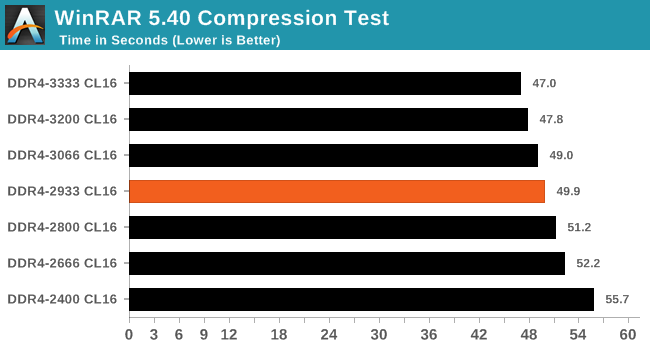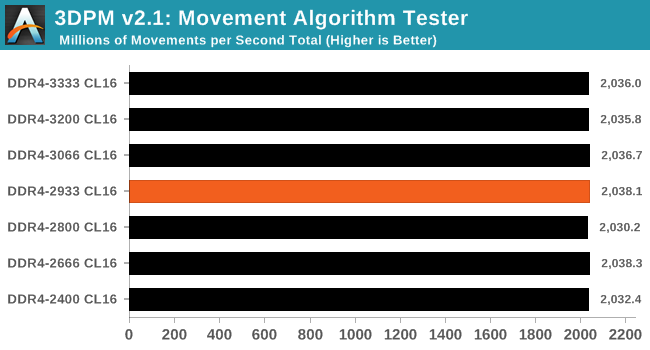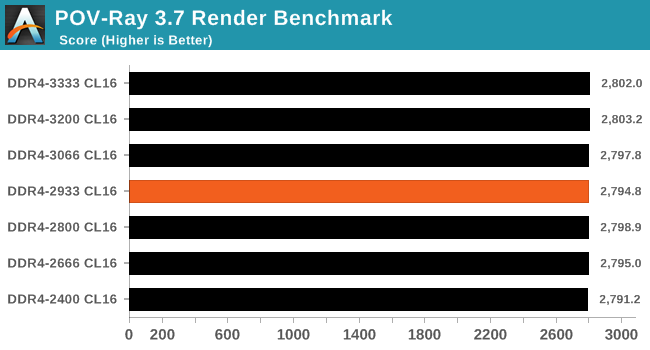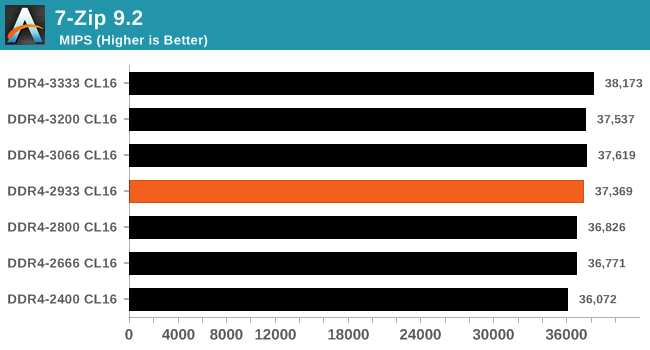Memory Scaling on Ryzen 7 with Team Group's Night Hawk RGB
by Ian Cutress & Gavin Bonshor on September 27, 2017 11:05 AM ESTCPU Performance, Short Form
For our quick reviews, we use our short form testing method.
Video Conversion – Handbrake v1.0.2: link
Video transcoding (both encode and decode) is a hot topic in performance metrics as more and more content is being created. First consideration is the standard in which the video is encoded, which can be lossless or lossy, trade performance for file-size, trade quality for file-size, or all of the above can increase encoding rates to help accelerate decoding rates. Alongside Google's favorite codec, VP9, there are two others that are taking hold: H264, the older codec, is practically everywhere and is designed to be optimized for 1080p video, and HEVC (or H265) that is aimed to provide the same quality as H264 but at a lower file-size (or better quality for the same size). HEVC is important as 4K is streamed over the air, meaning less bits need to be transferred for the same quality content.
Handbrake is a favored tool for transcoding, and so our test regime takes care of three areas.
Low Quality/Resolution H264: Here we transcode a 640x266 H264 rip of a 2 hour film, and change the encoding from Main profile to High profile, using the very-fast preset.

High Quality/Resolution H264: A similar test, but this time we take a ten-minute double 4K (3840x4320) file running at 60 Hz and transcode from Main to High, using the very-fast preset.

HEVC Test: Using the same video in HQ, we change the resolution and codec of the original video from 4K60 in H264 into 4K60 HEVC.

The biggest gains in Handbrake came in the HQ test where we gained up to an extra +21% in performance for DDR4-3333 over DDR4-2400. The fact that we don't see the same gains in the HEVC test is likely down to the algorithm.
Compression – WinRAR 5.40: link
For the 2017 test suite, we move to the latest version of WinRAR in our compression test. WinRAR in some quarters is more user friendly that 7-Zip, hence its inclusion. Rather than use a benchmark mode as we did with 7-Zip, here we take a set of files representative of a generic stack (33 video files in 1.37 GB, 2834 smaller website files in 370 folders in 150 MB) of compressible and incompressible formats. The results shown are the time taken to encode the file. Due to DRAM caching, we run the test 10 times and take the average of the last five runs when the benchmark is in a steady state.

Like with Handbrake, the system seemed to scale pretty well in WinRAR with a ~16% performance gain going from DDR4-2400 to DDR4-3333.
3D Movement Algorithm Test v2.1
This is the latest version of the self-penned 3DPM benchmark. The goal of 3DPM is to simulate semi-optimized scientific algorithms taken directly from my doctorate thesis. Version 2.1 improves over 2.0 by passing the main particle structs by reference rather than by value, and decreasing the amount of double->float->double recasts the compiler was adding in. It affords a ~25% speed-up over v2.0, which means new data.

Although more of a raw CPU benchmark, it shows here that memory isn’t a massive factor, as regardless of memory speed, we encountered marginal performance gains.
POV-Ray 3.7: link
Another regular benchmark in most suites, POV-Ray is another ray-tracer but has been around for many years. It just so happens that during the run up to AMD's Ryzen launch, the code base started to get active again with developers making changes to the code and pushing out updates. Our version and benchmarking started just before that was happening, but given time we will see where the POV-Ray code ends up and adjust in due course.

POV-Ray might be a fruitful benchmark for testing memory stability, but our performance variation between memory speeds was within the margin of error.
7-Zip 9.2: link
One of the freeware compression tools that offers good scaling performance between processors is 7-Zip. It runs under an open-source licence, is fast, and easy to use tool for power users. We run the benchmark mode via the command line for four loops and take the output score.

Some compression tools can be susceptible to memory performance and it shows in our results such as WinRAR. 7-zip has a small performance boost as we rise up through the stack, although the differences above DDR4-2666 are fairly minimal.










65 Comments
View All Comments
willis936 - Thursday, September 28, 2017 - link
QDR is the same thing as DDR with a the clock running at half frequency. It's not a magical way to make your datarates higher. The same paltry MHz increase would be seen on QDR but with just tighter jitter requirements. I don't see the benefit since DDR isn't running into a power limit.NeatOman - Thursday, September 28, 2017 - link
Now that i don't play to many games I'm ok with my 5 year old FX-8320@4.5GHz and R9 280x. Although i find that it does keep up with heavy multi-tasking, like having 20-50 tabs open while playing a FHD youtube video and working in SketchUp on a 40" 4K monitor. It also runs a file server, media server that real time transcodes 1080p in high quality, and i won't really notice while browsing and watching videos other than the lights getting brighter inside the case because the fans ramp up a bit.Zeed - Thursday, September 28, 2017 - link
Well poor test in my eyes... Gyuess You dont know that pass 3200 its TIMINGS ALL THE WAY !!!! Join us at Overclockers.net for PROPER numbers and tests with carious timings ect.BrokenCrayons - Thursday, September 28, 2017 - link
I hope your comment isn't an example of Overclockers.net writing quality. Proper numbers and tests aren't very useful when the supporting writing is almost incoherent.chikatana - Thursday, September 28, 2017 - link
I'm more interested in how will the system perform when all DIMMs are fully loaded.TAspect - Thursday, September 28, 2017 - link
All gaming tests are GPU bound, and that is why the CPU shows little to no scaling. The GTX 980 is clearly the bottleneck here. Either test with a GTX 1080 /Ti or lower settings until GPU is not a bottleneck.Tests only show average fps, which is a mistake as faster RAM affects minimum fps more than average. You should add 99% and 99.9% minimum fps to the graphs.
You should also include G. Skill Flare X 3200 CL14 RAM with the Stilt's 3200 fast OC profile found in the Crosshair VI Hero UEFI. On other MB's the settings are relatively simple to configure and you only have to test stability once instead of tuning all subtimings for days.
BrokenCrayons - Thursday, September 28, 2017 - link
Agreed on this. Game testing at more modest resolutions and settings would remove potential GPU bottlenecks from the results. Then again, there is a little bit of support for testing at settings closer to the settings an end user would realistically used on a daily basis. It does at least demonstrate the lack of change memory timings would have in a real-world gaming scenario. It'd be optimal to do both really so readers could see results free of GPU concerns AND see how memory perfomance will impact their day-to-day gaming.lyssword - Friday, September 29, 2017 - link
I think AT is one of the worst sites to get an idea of CPU gaming performance, always GPU limited or scripted part of the game with low cpu demand. Really the only time you see difference is 10% on bulldozer vs i7, where as in real world the difference is 40%. Most of the time AT test show almost no difference between core i3 and i7 because of that testing methodologyDabuXian - Thursday, September 28, 2017 - link
Trying to find a CPU bottleneck while using an old Geforce 980? Seriously? I'd expect some basic hardware knowledge from Anandtech?r3loaded - Friday, September 29, 2017 - link
I'd like to see what the effects are on Threadripper, considering that the IF spans two dies and the platform is geared towards maximising memory bandwidth.